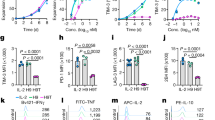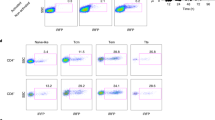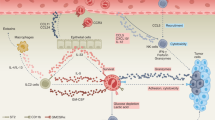Abstract
SUBCUTANEOUS implantation of isolated cell suspensions in mice gave a marked local eosinophil leucocyte reaction when the cells were of homologous and heterologous origin, but not when isologous normal cells or tumour cells of either native or foreign origin were used1. Implantation of isologous liver cells prepared from mice treated in vivo with hepatocarcinogenic compounds 3′-methyl-4-dimethyl-aminoazobenzene or o-aminoazotoluene resulted in a marked local eosinophil leucocyte reaction similar to that produced by the inoculation of genetically dissimilar cells2. It was suggested that the tissue specific antigen (TSA) of either foreign (homologous or heterologous) or native (isologous) cells, which had been altered or modified by the carcinogens, acted as ‘foreign’ within the isologous host and thus evoked a local eosinophil leucocyte reaction under these experimental conditions. Tumour cells lacking in TSA3–5 failed to evoke a similar reaction even though there was a much greater genetic diversity between the tumour and the host. Further experiments described here were performed to throw some light on the aforementioned hypothesis.
This is a preview of subscription content, access via your institution
Access options
Subscribe to this journal
Receive 51 print issues and online access
$199.00 per year
only $3.90 per issue
Buy this article
- Purchase on SpringerLink
- Instant access to full article PDF
Prices may be subject to local taxes which are calculated during checkout
Similar content being viewed by others
References
Goswami, P. K., Brit. Emp. Cancer Camp. Ann. Rep., 439 (1962).
Goswami, P. K., Brit. Emp. Cancer Camp. Ann. Rep. (1962).
Weiler, E., Brit. J. Cancer, 10, 553 (1956).
Nairn, R. C., Richmond, H. G., McEntergart, M. G., and Fothergill, J. E., Brit. Med. J., ii, 1335 (1960).
Nairn, R. C., Fothergill, J. E., McEntergart, M. G., and Richmond, H. G., Brit. Med. J., i, 1791 (1962).
Kaltenbach, J. P., Exp. Cell Res., 7, 568 (1954).
Murgatroyd, L. B., and Goswami, P. K., J. Med. Lab. Tech., 19, 398 (1962).
Baldwin, R. W., Cunningham, G. J., and Partridge, M. W., Brit. J. Cancer, 13, 94 (1959).
Baldwin, R. W., Palmer, H. C., Parfitt, R. T., Partridge, M. W., Vipond, H. J., and Cunningham, G. J., Brit. Emp. Cancer Camp. Ann. Rep., 418 (1961).
Old, L. J., Boyse, E. A., Clarke, D. A., and Carswell, E. A., Ann. N.Y. Acad. Sci., 101, 80 (1962).
Author information
Authors and Affiliations
Rights and permissions
About this article
Cite this article
GOSWAMI, P. Eosinophil Leucocyte Reaction to Tricycloquina-zoline-treated Cells and to this Chemical. Nature 202, 1227–1228 (1964). https://doi.org/10.1038/2021227a0
Issue date:
DOI: https://doi.org/10.1038/2021227a0



